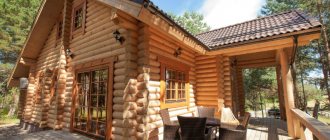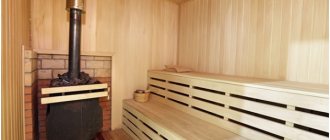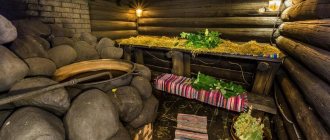From time immemorial, in Russian life and Russian tradition, the bathhouse has always been a sacred and magical place. There a person came into this world, and very often left it, they tried to determine their fate, one of the most evil and insidious house spirits lived there, and finally, a weekly ritual was held there, colloquially called a bath day. The Russian bathhouse is a symbol of the Russian spirit and way of life, in our story today.
Russian bathhouse: what is it, a little history
Baths appeared a long time ago. Back in the Stone Age, primitive people heated stones and poured water on them to create steam. Later in Ancient Greece, common steam rooms and washing rooms were built for the Spartans. The bathhouse in Rus' was popular back in 800-900. Then, for a while, the construction of baths stopped, and the bath traditions faded away.
In Europe and on the territory of modern Russia, full-fledged construction of baths began at the beginning of the 19th century. A Russian bath is not only about maintaining hygiene, but also a way to get rid of many ailments. The classic Russian bathhouse also performed sacred functions: babies were born here and old people died, girls came here to tell fortunes, and healers treated people.
Today, the Russian bathhouse is not used for daily washing, because everyone has baths and showers, but everyone loves to take a steam bath. Firstly, the bath cleanses not only the body, but also the soul. Secondly, it strengthens the immune system and increases the body’s protective functions and, thirdly, in the bathhouse you can wash away all the negativity, recover and “reboot”.
Unwashed Europe and clean Russia
Later sources indicate that bath culture also existed in Ancient Rome, whose rulers spread it to the conquered territories of Western Europe. However, after the fall of the Roman Empire, both the bathhouse and ablution as such were forgotten in Western Europe. There was a ban on bath culture, which was explained, among other things, by widespread deforestation and, as a consequence, a shortage of firewood. After all, in order to build a good bathhouse and heat it well, it is necessary to cut down a lot of trees. Medieval Catholic ethics also played a certain role, which taught that nudity of the body, even for washing, was sinful.
The decline in hygienic requirements led to the fact that Europe for many centuries was mired not only in its own sewage, but also in diseases. Monstrous epidemics of cholera and plague only for the period from 1347 to 1350. killed more than 25,000,000 Europeans!
Bath culture in Western European countries was completely forgotten, as evidenced by numerous written sources. Thus, according to Queen Isabella of Castile of Spain, she washed herself only twice in her life: when she was born and when she got married. An equally sad fate befell King Philip II of Spain, who died in terrible agony, consumed by scabies and gout. Scabies finally tormented and brought Pope Clement VII to the grave, while his predecessor Clement V died of dysentery, which he contracted because he never washed his hands. It is no coincidence, by the way, that dysentery began to be called “the disease of dirty hands” already in the 19th and 20th centuries .
Around the same period, Russian ambassadors regularly reported to Moscow that the king of France stank unbearably, and one of the French princesses was simply eaten by lice, which the Catholic Church called God's pearls, thereby justifying their senseless ban on baths and the culture of basic hygiene procedures.
No less curious and at the same time repulsive are the archaeological finds of medieval Europe, which today can be seen in museums around the world. Eloquently testifying to the widespread filth, stench and uncleanliness, exhibits are on display for visitors - scratchers, flea traps and saucers for crushing fleas, which were placed directly on the dining table.
Flea catcher - devices for catching and neutralizing fleas; in the old days an essential element of the wardrobe
Today it has already been proven that French perfumers invented perfumes not in order to smell better, but in order to simply hide the smell of a body unwashed for years under the fragrance of floral aromas.
Blokholovka
And all that remains is to sympathize with the daughter of Grand Duke Yaroslav the Wise , Anna , who, after marrying the French King Henry I , wrote to her father at home, saying:
Why did I anger you so much, and why do you hate me so much that you sent me to this dirty France, where I can’t even really wash myself?!
Types of Russian baths
There are two main types of these baths:
- A black sauna is a structure in which there is no chimney, and the smoke exits through the sauna doors. Soot and fumes are kept inside, which is considered the best way to disinfect. Previously, only black baths were taken, although today this method is largely a thing of the past.
- The white sauna is equipped in such a way that the smoke from the stove goes out into the smoker and, accordingly, the steam room is clean. This type of construction is used 99% of the time.
Black sauna
Which option to choose is a personal matter, but black saunas practically no longer exist.
Approximate material calculation
To carry out the calculation, you need to take into account what diameter the log will have. A larger one is better for a bath, but it is more expensive. The optimal diameter is 280 mm. The cost of 1 m3 of such logs with cups is on average about 8 thousand rubles.
Now you need to determine the height of the pediment. To do this, it is recommended to focus on natural conditions. In case of a large amount of precipitation, the gable should be high and the roof steep so that the snow does not linger on it, and in strong winds, vice versa, so as not to create excessive windage. The average height of the pediment is 1.5 m.
Photo gallery: drawings of a log house and necessary parameters
Top view and log cross-section parameters
A drawing of a log house will help in filling out the initial data
To calculate the amount of material, you must fill in all the initial data
A special calculator can help with the calculation.
All values can be entered into a special table
Features of the Russian bath
The Russian bathhouse is significantly different from the Finnish, Japanese, and Turkish ones. Peculiarities:
- Construction can be based on different designs. Standardly, the bathhouse has a dressing room, steam room, washing room or shower room. Modern structures are lined with swimming pools, lofts and recreation rooms.
- According to tradition, a heater is used for heating, which heats up to +600°C and at the same time heats the air to +100°C, but due to almost 100% humidity the heat is not felt.
- The steam room has benches located in several tiers, and the higher the tier, the hotter it is.
If you read the description of a Russian bath, it becomes clear that it differs from a hammam or Finnish sauna in its high humidity. Due to this, you can fully sweat and get rid of toxins and many diseases, the appearance of which is caused by pathogenic microorganisms.
What tool will you need?
To build a bathhouse with your own hands you need:
- electric saw;
- grinder with a set of discs;
- drill with various drills and grinding attachments;
- planer, jointer (or electric analogues);
- axes;
- crowbar, mount;
- pliers, nail puller;
- bayonet and shovel;
- hydraulic level;
- hammers;
- mallet;
- bit;
- set of chisels;
- files;
- caulk tool;
- tape measure and carpenter's meter;
- buckets;
- wheelbarrow;
- stairs;
- construction trestles;
- container for concrete or construction mixer.
Now you can proceed directly to construction.
How to go to a Russian bathhouse correctly
A real Russian bathhouse benefits the body and has a beneficial effect on the functioning of all organs and systems:
- strengthens the walls of blood vessels, improves blood circulation;
- normalizes heart rate and blood pressure;
- stimulates intestinal contractility, improving the functioning of the gastrointestinal tract;
- eliminates pathologies of the musculoskeletal system, expels salts from joints, increases their mobility;
- strengthens the immune system;
- eliminates pathogenic microflora, inhibits all types of pathogens.
In order not to get the opposite effect from the bath, it is important to follow the basic rules:
- eating no later than 2 hours before the steam room;
- abstain from alcohol for a day;
- in the bathhouse do not drink alcohol and do not eat fried or fatty foods;
- enter the steam room wearing a special felt cap, which protects the hair and scalp from high temperatures;
- You can take juices and green tea to the bathhouse.
If you feel unwell, have high blood pressure, have a fungal skin disease, or have problems with internal organs, it is recommended to consult a specialist before visiting the bathhouse.
Massage with brooms
Contraindications
In addition to its indications and beneficial effects, the Russian steam room has a number of contraindications. You cannot go to the bathhouse in the following cases:
- atherosclerosis, heart failure, ischemic disease, hypertension;
- thrombophlebitis, varicose veins;
- tendency to bleed;
- Parkinson's disease;
- oncological diseases;
- asthma.
You should also not steam during pregnancy, during menstruation, or while breastfeeding.
Top secret
The first to notice the healing properties that the bath has on the human body were the Magi - the most advanced and educated part of the then pre-Christian society. It was they who began to practice the use of two key natural elements, fire and water, and additional ones - medicinal herbs, in their medical practice.
Moreover, there is reason to believe that already at that time such a thing as a physiological clock was known - a certain cycle of occurrence, activation or, conversely, attenuation of basic physiological processes. Unfortunately, the lion's share of the knowledge of that time was irretrievably lost, along with the departure from the historical scene of the pagan religion and its bearers. The basis of the pagan world was maximum unity with nature.
Therefore, the Russian-style bathhouse was performed with maximum use of the gifts of nature. The place was chosen near a water source, logs were provided by the forest, a stone for the heater was provided by a cliff on the river bank, even the cracks between the logs and beds were filled with a mixture of soaked forest moss and resin - the resin of coniferous trees.
Traditions provide for the widespread use of medicinal herbs and roots. The most common ones should be mentioned separately:
- Mint is a well-deserved and revered spicy plant with an excellent mild aroma and excellent properties by all bathhouse attendants. Calms the nervous system and stimulates brain activity. In the pagan era, hunters of large animals, primarily bears, enjoyed the mint aroma in the bathhouse. Modern scientists associate this fact with some suppression of the activity of the human central nervous system, as a result of which all the actions of the hunting party were distinguished by thoroughness and prudence. Excessive nervousness and fuss are bad helpers in such a matter;
- St. John's wort - when a decoction of this herb was added to the hot stones of the stove, a very good herbal background was created. St. John's wort itself does not have a dominant, pronounced aroma, but the abundance of essential oils makes it an indispensable inhaler in the treatment of the upper respiratory tract, and simply as a preventive measure for such diseases;
- Chamomile - unlike mint, was used as a relaxing and tonic. It was chamomile decoction that was the first remedy in the bathhouse for a walker or traveler before they set off on a long journey. The abundance of microelements and muscle fiber stimulants in the aqueous extract of this herb helped to better and more functionally endure monotonous physical activity, primarily associated with endurance indicators. Experts in Volga life claim that the most enduring gangs of barge haulers were from Nizhny Novgorod. They say the workers there knew a centuries-old recipe for a herbal bath infusion, which included elecampane, chamomile, and oregano. The complete recipe has been lost, but enthusiasts are trying to restore it. After all, a bath taken with such a drug guaranteed high-quality work for an average barge hauler for 12-14 days. Exactly until the next bath;
- Horseradish - a ladle of infusion of the root poured onto a heater, drove out any, even the most chronic cold from the body. It also suppressed rheumatoid pain, not without success. True, the principle of application was somewhat different. A birch broom was pre-soaked in the infusion.
Basic attributes of a Russian bath
A traditional Russian bathhouse is not complete without a broom. It can be made of oak, birch, willow, maple or any other tree or plant. Each broom has its own advantages.
A full-fledged bathing procedure is also impossible without high-quality stones that are placed in the steam room. They are heated by the stove and when water enters they create thick, dense steam. It is recommended to choose stones responsibly in order to benefit from the steam room. The most common are jadeite, dunite, porphyrite.
Attributes of a Russian bath
Read the blog for even more detailed and interesting information about baths and bath procedures.
Video description
The video will show one of the options for constructing a columnar foundation for a bathhouse:
Construction and insulation of walls
In the upper part of the strip foundation it is necessary to make holes for the ventilation system. They should be located on walls opposite each other. Then a blind area made of clay and crushed stone is built along the perimeter of the outer side of the base. Its thickness must be at least 5 cm.
The surface of the foundation is covered with several layers of roofing felt. After this, the walls are erected. If they are made of timber, then the lower trim is placed on rods protruding from the base. To do this, holes 10 cm deep are drilled along its perimeter and pieces of reinforcement are inserted into the solution.
Each subsequent row of timber is secured together with dowels. The crowns are connected by dowels. All grooves are insulated with a plait. Construction continues to the intended height, not forgetting to leave openings for doors and windows. After this, beam floors are cut into the structure.
Rafter ends are installed on them, the crowns of which are connected at the ridge. There must be a spacing of at least one meter between the rafters. The sheathing and ridge board are nailed on top. Vapor barrier and waterproofing are laid. The construction of the bathhouse frame is completed by laying the roofing material.
Construction of a bathhouse from timber Source stroyfora.ru
The steam room in the bathhouse is thermally insulated according to the principle of a thermos. This method is also called “pie”. First, a windproof film is attached to the surface from the inside. Bars with a cross section of 50×40 mm are screwed vertically on top. The distance between them should be equal to the width of the insulation boards. The cavities are filled with insulator. Basalt is considered the best for a bath, since it does not support combustion.
Waterproofing in the form of a bath membrane or thick foil is attached to the bars with galvanized staples. All joints are sealed with adhesive tape. And after that, the sheathing is attached to the bars with self-tapping screws. For it, slats with a cross section of 25×40 mm are selected. It is necessary to maintain a step of 70 cm between them. The “pie” is completed by the lining, which is nailed with galvanized nails.
Floor arrangement
Concrete screed is justified only in the area of the shower and swimming pool. In all other parts of the bathhouse it is better to make a regular wooden floor. To do this, a board 40-50 mm thick is nailed to the joists of the lower trim. Moreover, there is no need to fit them very tightly to each other. All the same, the joints will open from excessive moisture. And small gaps will be useful for ventilation.
Work on the floor in the future steam room Source 1-teplodom.ru
There should be a distance of half a meter from the transverse joists to the ground. There is no need for a “warm floor” in the steam room. Because the room is empty after use. And during bath procedures, a little coolness on the surface is not of fundamental importance. After all, you can only steam as much as possible by lying on a shelf under the ceiling.
Tips for interior decoration of the steam room
Even at the construction stage, it is necessary to use modern impregnating compounds that can withstand high temperatures and humidity without harming human health. This way you can protect the building from fungus and rot. Those that are suitable for the ceiling cannot always be used to cover furniture.
Manufacturers of varnishes and paints (Senezh, Empils, Rogneda, Dulux, Tikkurila, Nobel, Belinka, Teknos) produce many such products with water-repellent natural substances such as paraffin, wax, oil. They are divided into those suitable for external walls, internal surfaces that a person does not touch with his body (ceiling) and furniture.
Silicone impregnation suitable for ceilings
Pyroprotective and antiseptic impregnation of logs is usually done at the timber mill, but it must be done again after construction.
The first application of the compositions to furniture is carried out immediately after its manufacture on a dry and clean surface, or even before manufacture (on wooden blanks). The product should be evenly distributed with a sponge, soft cloth or brush. Due to the thick consistency, a spray gun will not work.
Impregnation can be applied with a sponge, brush, or cloth.











